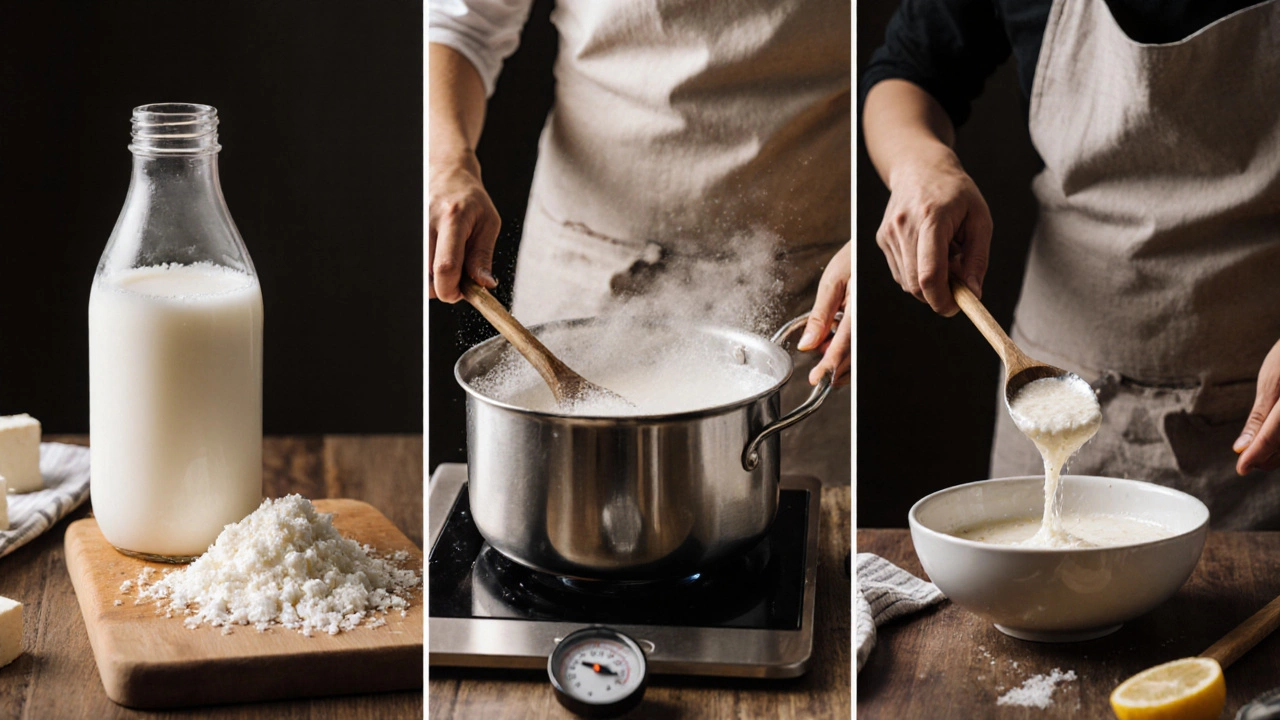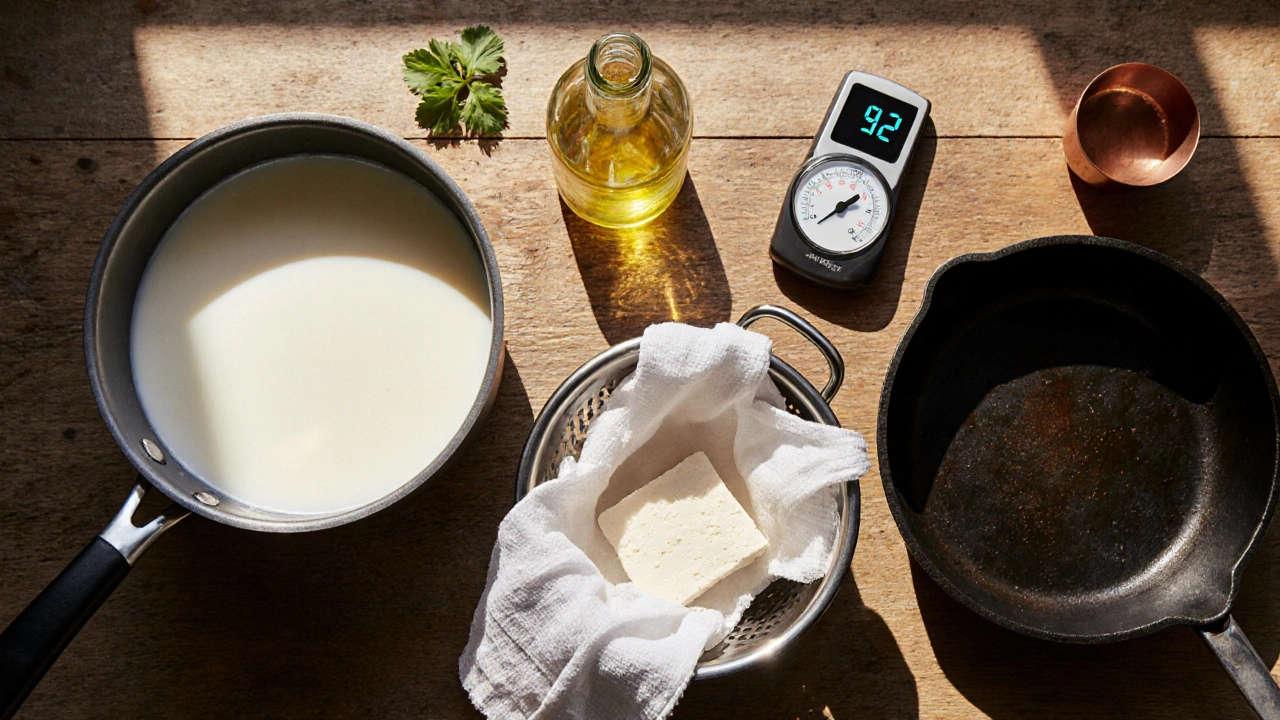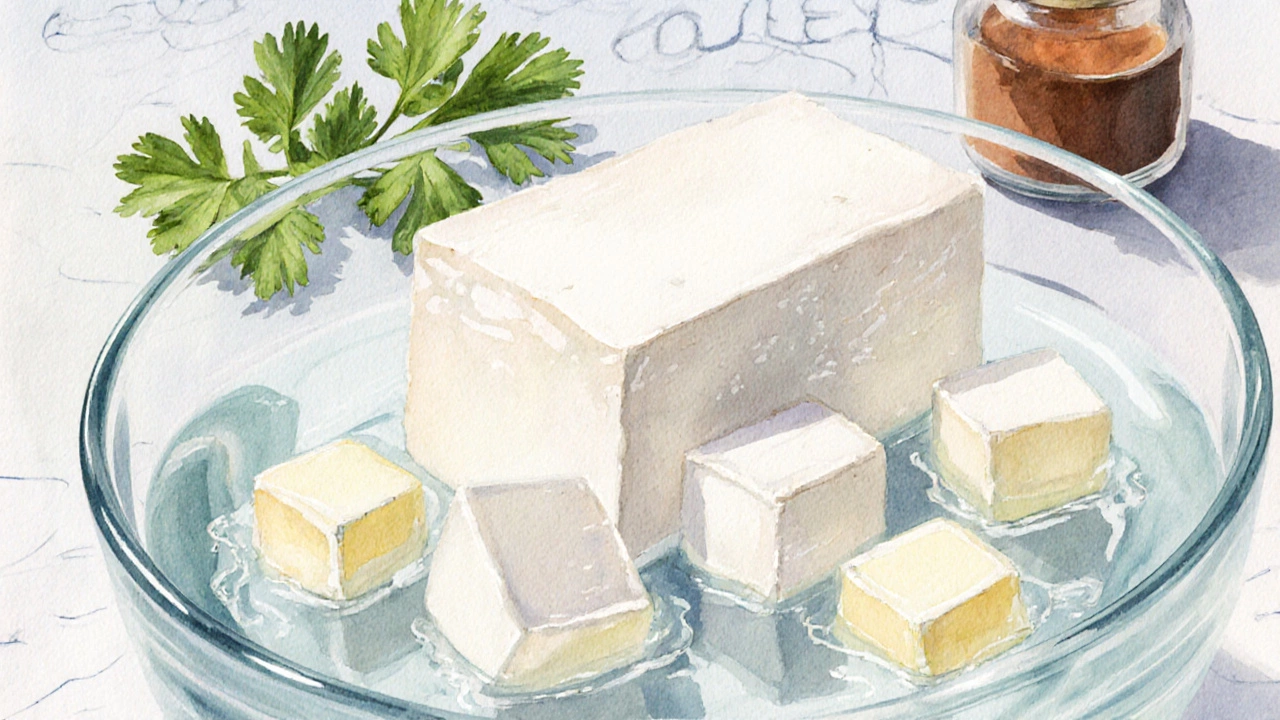Common Mistakes When Making Homemade Paneer (And How to Fix Them)

Paneer Making Calculator
Enter your milk quantity to calculate the exact amount of acid needed, plus temperature guidance for perfect paneer.
Ideal milk temperature for curdling:
Remove from heat when small bubbles form at edges
Ever wonder why your homemade paneer turns out grainy, watery, or just flat? The culprit is usually a simple mistake that anyone can avoid. Below you’ll learn exactly what goes wrong, why it happens, and how to get soft, melt‑in‑your‑mouth paneer every time.
Quick Takeaways
- Use full‑fat, non‑UHT milk - it builds a richer curd.
- Heat milk to the right temperature (around 90‑95 °C) and avoid a rolling boil.
- Add the acid (lemon juice, vinegar, or rennet) at the correct temperature.
- Drain with a clean cheesecloth and press gently.
- Store in cold water or butter for up to a week.
Understanding Paneer
Paneer is a fresh Indian cheese made by curdling hot milk with an acid coagulant and then pressing the resulting curds. It stays firm without melting, making it perfect for curries, grills, and salads. Because it’s a simple acid‑set cheese, the whole process hinges on a few critical variables - temperature, acidity, and handling.
Essential Ingredients and Tools
Milk is the base of paneer. Full‑fat, pasteurised milk (not ultra‑high‑temperature) provides the protein and fat needed for a smooth curd. Lemon juice is the most common acid coagulant, but vinegar or rennet can also be used. A cheesecloth helps separate curds from whey while keeping the curd intact. A kitchen thermometer lets you hit the sweet spot between 90 °C and 95 °C, and a sturdy stovetop gives steady heat.

Most Common Mistakes and How to Fix Them
- Using the wrong milk. Low‑fat or UHT milk gives a crumbly, dry paneer because there isn’t enough fat to bind the proteins. Fix: Stick to full‑fat (3.5 % +) pasteurised milk. If you only have skimmed milk, add a tablespoon of cream per litre.
- Over‑heating the milk. Letting the milk reach a rolling boil denatures the proteins so they can’t form a tight curd, resulting in a rubbery texture. Fix: Heat slowly and watch for tiny bubbles forming around the edges. Remove from heat at around 90‑95 °C.
- Adding acid at the wrong temperature. If the milk is too hot, the curd forms instantly and becomes grainy; if it’s too cool, the curd may not set at all. Fix: Turn off the heat, wait 2‑3 minutes, then stir in the acid gently.
- Using too much or too little acid. Excess acid creates a squeaky, watery curd; too little leaves large milk lumps. Fix: Start with 2 tablespoons of lemon juice per litre of milk, add a little more if curdling is incomplete.
- Not draining properly. Skipping the cheesecloth or squeezing the curd too hard squeezes out the moisture that keeps paneer soft. Fix: Line a colander with cheesecloth, let the whey drain for 5‑10 minutes, then gently gather the corners and press lightly.
- Pressing too hard or for the wrong duration. A heavy press makes paneer dense and tough; too light leaves it crumbly. Fix: Place the wrapped curd under a 1‑kg weight for 30 minutes. Adjust based on desired firmness.
- Storing incorrectly. Keeping paneer dry in the fridge dries it out, while storing it in water without changing the water makes it sour. Fix: Store in a container of fresh cold water, changing the water daily, or submerge in melted butter for richer flavour.
Step‑by‑Step Guide to Perfect Paneer
- Measure 2 litres of full‑fat milk and pour it into a heavy‑bottomed saucepan.
- Place the pan on the stovetop over medium heat. Using a thermometer, bring the milk to 92 °C (just before a full boil). Stir occasionally to avoid scorching.
- Turn off the heat. Let the milk sit for 2 minutes.
- Slowly stir in 2 tablespoons fresh lemon juice (or 1.5 tablespoons white vinegar). You’ll see the milk separate into curds (white) and whey (clear).
- Let the mixture sit undisturbed for 5 minutes so curds fully form.
- Line a colander with a double layer of cheesecloth. Carefully pour the curdled mixture into the colander to drain.
- Gather the cloth’s corners and tie them into a pouch. Hang the pouch over the sink or place it on a plate and set a 1‑kg weight on top. Press for 30 minutes.
- Unwrap the paneer block. Cut into cubes or slices as needed.
- If you’re not using it immediately, store the block in a bowl of cold water in the fridge. Change the water daily. For richer taste, submerge in melted butter.

Pro Tips & Tools
- Thermometer: Guarantees the perfect temperature range; cheaper infrared models work well for home kitchens.
- Cheesecloth: Use a clean, tightly‑woven muslin cloth. Avoid hemp or loosely woven fabrics that let curds slip through.
- Stovetop control: A gas burner gives the most even heat. If you use electric, keep the flame low to avoid scorching.
- Acid choice: Lemon juice adds a fresh citrus note, while vinegar gives a neutral flavour. Rennet produces a smoother texture but is more expensive.
Common Errors at a Glance
| Mistake | Visible Symptom | How to Fix |
|---|---|---|
| Low‑fat or UHT milk | Dry, crumbly curds | Use full‑fat pasteurised milk; add cream if needed |
| Milk boiled too hard | Rubbery texture | Heat to 90‑95 °C, stop before a rolling boil |
| Acid added while milk still boiling | Grainy, uneven curd | Remove from heat, let sit 2‑3 min before adding acid |
| Too much/too little acid | Squeaky curd or no curd | Start with 2 Tbsp lemon juice per litre; adjust incrementally |
| Skipping cheesecloth drainage | Watery, loose paneer | Drain through cheesecloth for 5‑10 min |
| Pressing too hard or too long | Dense, tough block | Press with 1 kg weight for 30 min; adjust based on desired firmness |
| Storing dry in fridge | Hard, cracked surface | Store in cold water or butter, change water daily |
Mini FAQ
Can I use skimmed milk to make paneer?
Skimmed milk will produce a very dry, crumbly paneer because the missing fat can’t bind the proteins. If you have to use it, blend in a tablespoon of heavy cream per litre of milk to improve texture.
Why does my paneer turn yellow?
A yellow hue usually means the milk was heated too long, causing caramelisation. Keep the temperature below 95 °C and watch for the first signs of steam to stop heating in time.
Is rennet better than lemon juice?
Rennet produces a smoother, less grainy curd and is favored in commercial settings, but it’s pricier and harder to find. Lemon juice works great for home cooks and adds a subtle citrus note.
How long can homemade paneer be kept?
Stored in fresh cold water or butter, paneer stays good for 5‑7 days in the fridge. Freeze it for up to 2 months, but texture will become slightly crumbly after thawing.
Can I add herbs or spices to the paneer while making it?
Yes, mix finely chopped herbs (like cilantro or mint) or a pinch of salt into the curds before pressing. This infuses flavor directly into the cheese.
Now that you know the typical pitfalls, you can skip the trial‑and‑error and make paneer that’s tender, milky, and ready for any Indian recipe. Happy cooking!